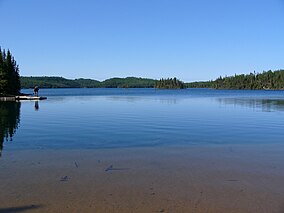Slate Islands (Ontario)
| Slate Islands Provincial Park | |
|---|---|
|
IUCN category II (national park)
|
|

McGreevy Harbour, Slate Islands, was once used as a staging area for logs during the logging boom of the 1930s
|
|
| Location | Ontario, Canada |
| Nearest city | Terrace Bay, Ontario |
| Coordinates | 48°39′0″N 87°00′0″W / 48.65000°N 87.00000°WCoordinates: 48°39′0″N 87°00′0″W / 48.65000°N 87.00000°W |
| Area | 65.70 km2 (25.37 sq mi) |
| Established | 1985 |
| Governing body | Ontario Parks |
The Slate Islands archipelago is formed of two main islands, five minor islands and numerous islets located in northern Lake Superior, 10 kilometres (6 mi) south of the town of Terrace Bay. The islands were created by a meteorite impact which formed a crater about 32 km (20 mi) wide. In 1985, the Ontario government established the Slate Islands as a natural environment provincial park. The islands are notable for having Ontario's largest herd of boreal woodland caribou.
The total surface area is about 36 square kilometres (14 sq mi). The nearby Leadman Group of islands one km (0.6 mi) east is often considered part of the Slate Islands.
The islands are home to woodland caribou which have been studied extensively from 1974 to today by Dr. A.T. (Tom) Bergerud. The caribou are a classic example of island biogeography in action; the islands are notable for species that are absent but present on the adjacent mainland (red squirrel, moose, white-tailed deer, and grouse). No ungulates were present on the islands until the caribou arrived in the early 1900s. And, no predators of caribou were (or are currently) present. Caribou reached the highest population density in the world on the islands before the 1990s, with the herd estimated at 650 animals. After a food shortage and die-off in 1990, the numbers were reduced to about 100. In 2012 there are about 200 caribou on the Slate Islands. Wolves reached the archipelago in the early 1990s preying heavily on the caribou but for reasons not entirely known they disappeared a few years later.
Other mammals found on the islands include beaver, muskrat, snowshoe hare, short-tailed weasel, red-backed vole, and red fox.
The waters surrounding the Slate Islands have been protected from commercial fishing to preserve one of the last native stocks of lake trout in Lake Superior. The Islands have been a source of lake trout brood stock used at the Dorion Fish Hatchery, and fingerlings are planted back to Lake Superior to restore the fishery.
...
Wikipedia

